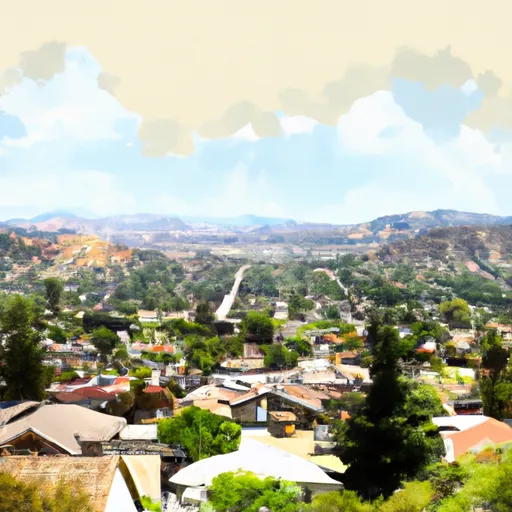-
 Snoflo Premium
Snoflo Premium
Get unlimited access to all our content
With no Ad interruptions! - Start Your Free Trial Login with existing account
Jamul
Eden Index
Climate
9.2
•
Recreation
5.1
•
Community
6.1
•
Safeguard
7.0/10

Jamul, California is a small community located in San Diego County. The climate in Jamul is typically Mediterranean, with warm, dry summers and mild, wet winters. Summers are characterized by average high temperatures of around 85°F (29°C), while winters see average highs of about 67°F (19°C). Precipitation is relatively low, with an average of 14 inches (36 cm) per year, mostly occurring between November and March.
Hydrologically, Jamul is home to several creeks and small rivers, including the Dulzura and Jamul Creek. These waterways contribute to the larger Sweetwater River watershed. The area also features some small ponds and lakes, providing opportunities for fishing and boating.
Outdoor recreation in Jamul is abundant. The community is surrounded by scenic mountains and valleys, making it a great destination for hiking, camping, and horseback riding. Jamul offers many trails to explore, such as the Lawson Peak Trail and the Hollenbeck Canyon Wildlife Area. Additionally, the nearby Jamul Mountains provide opportunities for off-roading and ATV adventures. With its diverse natural landscape and pleasant climate, Jamul is a haven for outdoor enthusiasts seeking to connect with nature.
What is the Eden Index?
The Snoflo Eden Index serves as a comprehensive rating system for regions, evaluating their desirability through a holistic assessment of climate health, outdoor recreation opportunities, and natural disaster risk, acknowledging the profound impact of these factors on livability and well-being.
Climate Health Indicator (CHI): 9.2
Jamul receives approximately
457mm of rain per year,
with humidity levels near 74%
and air temperatures averaging around
17°C.
Jamul has a plant hardyness factor of
10, meaning
plants and agriculture in this region tend to thrive here all year round.
By considering the ideal temperature range, reliable water supplies, clean air, and stable seasonal rain or snowpacks, the Climate Health Indicator (CHI) underscores the significance of a healthy climate as the foundation for quality living.
A healthy climate is paramount for ensuring a high quality of life and livability in a region, fostering both physical well-being and environmental harmony. This can be characterized by ideal temperatures, reliable access to water supplies, clean air, and consistent seasonal rain or snowpacks.
Weather Forecast
Streamflow Conditions
Laguna-San Diego Coastal
Area Rivers
Laguna-San Diego Coastal
Snowpack Depths
Laguna-San Diego Coastal
Reservoir Storage Capacity
Laguna-San Diego Coastal
Groundwater Levels
Recreational Opportunity Index (ROI): 5.1
The Recreational Opportunity Index (ROI) recognizes the value of outdoor recreational options, such as parks, hiking trails, camping sites, and fishing spots, while acknowledging that climate plays a pivotal role in ensuring the comfort and consistency of these experiences.
Access to outdoor recreational opportunities, encompassing activities such as parks, hiking, camping, and fishing, is crucial for overall well-being, and the climate plays a pivotal role in enabling and enhancing these experiences, ensuring that individuals can engage in nature-based activities comfortably and consistently.
Camping Areas
| Campground | Campsites | Reservations | Toilets | Showers | Elevation |
|---|---|---|---|---|---|
| Sweetwater Summit | 112 | 280 ft | |||
| Santee Lakes Regional Park | 300 | 323 ft | |||
| Dos Picos | 68 | 1,505 ft | |||
| Lake Jennings | None | 706 ft |
Catastrophe Safeguard Index (CSI):
The Catastrophe Safeguard Index (CSI) recognizes that natural disaster risk, encompassing floods, fires, hurricanes, and tornadoes, can drastically affect safety and the overall appeal of an area.
The level of natural disaster risk in a region significantly affects safety and the overall livability, with climate change amplifying these risks by potentially increasing the frequency and intensity of events like floods, fires, hurricanes, and tornadoes, thereby posing substantial challenges to community resilience and well-being.
Community Resilience Indicator (CRI): 6.1
The Community Resilience Indicator (CRI) recognizes that education, healthcare, and socioeconomics are crucial to the well-being of a region. The CRI acknowledges the profound impact of these elements on residents' overall quality of life. By evaluating educational resources, healthcare accessibility, and economic inclusivity, the index captures the essential aspects that contribute to a thriving community, fostering resident satisfaction, equity, and social cohesion.

